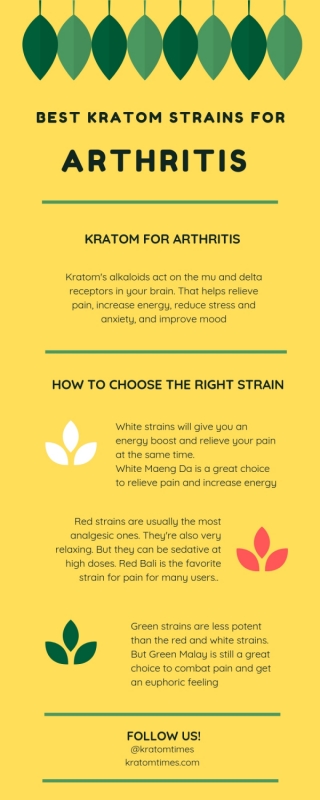Thanks to its pain-relieving properties, kratom is becoming very popular among people looking for natural alternatives for pain. In this article, we will explore the benefits of using kratom for arthritis, a very painful condition that affects millions of people.
What Is Arthritis?
Arthritis is not one single disease, but a general term that refers to an inflammation of one or more of your joints. This inflammation causes pain or joint disease. Sadly, it is a common, yet complex, condition and its causes are not always clear.
While there are several types of arthritis, they all share some similar symptoms, such as joint pain, swelling, stiffness, and decreased range of motion. These symptoms may come and go, and often worsen with time.

The most common type of arthritis is osteoarthritis. Osteoarthritis is a degenerative condition that occurs when the cartilage in your joint is damaged. The cartilage in your bones wears away and bone grinds on bone, which results in inflammation, pain, and stiffness.
Another common type of arthritis is rheumatoid arthritis, which is an auto-immune condition. In this case, your own body attacks your joints by sending fluid and blood to fight an infection that doesn’t exist. Of course, this is a mistake your body commits, since that infection is not real. But that fluid that your body sends causes inflammation in or around the joint area. This inflammation will damage your joint and your bone and will cause pain, swelling, stiffness, and fatigue.
But there are also some infections that can cause arthritis. Infectious arthritis can be due to a bacterium or a virus, such as salmonella, gonorrhea or hepatitis C. Quite often, the treatment for the infection will also cure arthritis. However, this is not always the case and sometimes infectious arthritis can become chronic.
Finally, another common type of arthritis is gout. Gout occurs when uric acid builds up and forms crystals in the joints. People suffering from gout experience extreme pain. But when the levels of uric acid go down, the symptoms go away. Nonetheless, when the uric acid levels increase, gout will return. That’s why, if you are suffering from gout keeping a strict diet that balances the uric acid levels is crucial to prevent gout attacks.
Kratom Basics
Kratom is the common name of Mitragyna speciosa, an evergreen tree that grows in Southeast Asia. For many centuries, the native population of Indonesia or Thailand used to chew or make into tea kratom’s fresh leaves to get the energy that would allow them to endure their harsh working conditions. In some places, such as Thailand or Malaysia, it was a natural remedy to fight morphine or opium dependence.
Today, kratom has also become popular in the Western world and millions of people use it to relieve pain, fight fatigue, manage the symptoms of anxiety and depression, or even to cope with opiate withdrawal.
What Are the Benefits of Kratom for Arthritis?
Thanks to its analgesic properties, kratom can help alleviate the symptoms of arthritis.
The leaves of M. speciosa contain more than 20 alkaloids and other phytochemicals, such as mitragynine (the most abundant one) or 7-hydroxymitragynine, that act on your opioid receptors. These receptors are responsible for managing (and relieving) pain. Thus, when you ingest kratom, its alkaloids activate these opioid receptors in your brain. Then, the opioid receptors send signals to the brain of blocking pain. Opioids and opiates (which are part of the traditional treatments for arthritis) also work this way. That is why the opioid receptors get this name because opioids activate them. But unlike opioids, kratom will not cause respiratory depression and is not addictive. Furthermore, its effects last for a few hours.
The opioid receptors also regulate mood, energy, sociability, euphoria, stress or even physical dependence. As a result, kratom has other effects:
- Stimulating
- Relaxing
- Euphoric
- Anti-inflammatory
- Sedative
That’s why kratom can help people cope with so many different issues. At low doses, kratom’s effects are more stimulating, while they are more relaxing at high doses.
Best Kratom Strains for Arthritis
If you are a kratom newbie, you may feel overwhelmed by the great number of kratom varieties available. All kratom strains have analgesic properties. However, they will also have other effects depending on the variety.
There are three main types of kratom, depending on the color of the leaf’s stem and vein: red kratom, white kratom, and green kratom. But each of these types has different sub-varieties or strains, usually (but not always) named after the place of origin of that specific kratom (e.g., red Indo kratom or green Malay kratom).
- Red kratom: Red kratom varieties (or strains) are the most sedating ones. The analgesic effects of the red strains are incredibly potent, but they can also be very sedating at high doses. Therefore, you should be cautious when using red kratom strains, especially if you are a kratom newbie. Red Bali is arguably the best kratom strain for pain for many users, and it also has strong relaxing effects. Other red choices for pain are red Borneo (which you can use at night due to its potent sedating properties) and red Hulu (which doesn’t have sedating effects and, therefore, you can use it during the day).
- White kratom: Just at the opposite side of the spectrum, white kratom is praised for its stimulating and euphoric effects. While in general white kratom strains are not so analgesic as the red strains, they will still help you alleviate pain. Furthermore, white kratom will also boost your energy up and enhance your mood thanks to its euphoric effects. White Maeng Da is a great strain if you want to relieve pain and get an energy boost at the same time.
- Green Kratom: Green varieties are usually not so potent as red or white strains. Nonetheless, green kratom varieties comprise the full spectrum of kratom’s effects and that’s why they are still an excellent choice. Most kratom users praise green Malay kratom for its analgesic, stimulating, and euphoric properties.

How to Use Kratom
There are many ways to take kratom. People usually brew it and make a tea. But there are many users who prefer to toss and wash kratom, although this method can be a bit cumbersome. You can also take kratom capsules, which is a very convenient way of consuming kratom. However, this method also has some disadvantages. For instance, capsules are more expensive than powder and they take longer to kick in. Since the taste of kratom tea is far from good, there are users who add kratom to smoothies, yogurt or juices. A common way of consuming kratom is by adding it to applesauce.
But regardless of how you choose to consume kratom, you should always be cautious with the dosage. If you don’t know how to establish your kratom dosage, this guide might help you:
- Starting dosage for beginners: 2-3 grams
- Low dosage: 2-4 grams
- Moderate dosage: 4-5 grams
- High dosage: 5-8 grams (not recommendable if you’re not an expert user)
Doses higher than 8 grams are in general too high for most users. This amount of kratom could produce sedation and even stupor.
Moreover, kratom can also have side effects:
- Nausea
- Constipation
- Dizziness
- Migraines
- Dehydration
- Eye wobbles
The best way to avoid these side effects is by being cautious with the dose. Also, high kratom doses and regular use (taking kratom daily) can lead to kratom tolerance. Tolerance occurs when your body doesn’t feel the effects of kratom anymore.
Finally, if you want to use kratom for arthritis talk to your doctor first, especially if you are using traditional analgesics. You should never mix kratom and opioids or other medications for pain.


